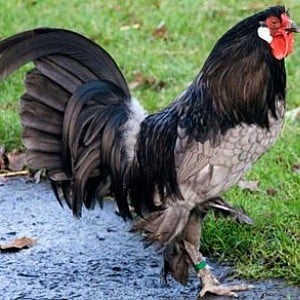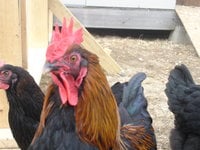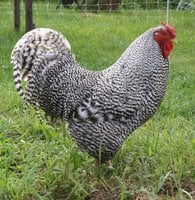Experienced our Blue Breda 4 m/o pullet who shipped to us w/ her best friend a Blue Ameraucana pullet 2 weeks ago - they were hatchmates and always pal'd around together. The vet's fecal lab tests showed they came w/ round worms so we treated them both for that. Secondly the Breda must have stressed from the shipping, plopped in a new environment, w/ new people so she exhibited CRD symptoms so we had to treat her for that. Now they are both back to good health again. Thirdly we are now experiencing the Breda picking at her toe feathers to the point that her companion started to pick at the blood - so we immediately began dipping the Breda's legs in Grannick's Bitter Apple a couple times a day to keep both birds from pecking the toes. I was prepared for these issues in getting a Breda but just didn't think all of it would happen the moment she arrived. We experienced having a Silkie with delicate health so maintenance on gentle breeds is routine for us.
Health issues aside we are thrilled with the Breda personality - calm, curious, unafraid of coming up to receive a treat from the hand, easily picked up, one of the easiest breeds I've ever had that tamed so quickly. Hope she continues this attribute at full maturity. JC Poultry said Breda tend to be easily bullied and bottom of pecking order so we have nothing but gentle breeds in the flock - APA Ameraucanas, Silkies, and her. I'm not fond of the health issues like susceptibility to CRD, Bumblefoot, broken toe feathers - but we are aware watching for these things thanks to previous input from other owners/ breeders. I have a Silkie w/ similar issues and we know when a hen is "off" to schedule a vet visit. Taking a chicken is no more tedious than taking a cat or dog to the vet except that the chickens get a lot more attention in the vet office! A tall rare Breda w/ no comb and cavernous nostrils is worth a capture on the vet's camera phone!
There are hardier, more prolific, meatier breeds in the chicken world but I have yet to come across other breeds so uniquely rare and regal in appearance as the Breda along w/ a gentle nature. The non-combative Breda personality is so perfect for our gentles flock who are non-combative breeds. Breda is so worth keeping around just for her personality alone - the beauty and eggs yet to come will just be an added bonus!
Health issues aside we are thrilled with the Breda personality - calm, curious, unafraid of coming up to receive a treat from the hand, easily picked up, one of the easiest breeds I've ever had that tamed so quickly. Hope she continues this attribute at full maturity. JC Poultry said Breda tend to be easily bullied and bottom of pecking order so we have nothing but gentle breeds in the flock - APA Ameraucanas, Silkies, and her. I'm not fond of the health issues like susceptibility to CRD, Bumblefoot, broken toe feathers - but we are aware watching for these things thanks to previous input from other owners/ breeders. I have a Silkie w/ similar issues and we know when a hen is "off" to schedule a vet visit. Taking a chicken is no more tedious than taking a cat or dog to the vet except that the chickens get a lot more attention in the vet office! A tall rare Breda w/ no comb and cavernous nostrils is worth a capture on the vet's camera phone!
There are hardier, more prolific, meatier breeds in the chicken world but I have yet to come across other breeds so uniquely rare and regal in appearance as the Breda along w/ a gentle nature. The non-combative Breda personality is so perfect for our gentles flock who are non-combative breeds. Breda is so worth keeping around just for her personality alone - the beauty and eggs yet to come will just be an added bonus!




